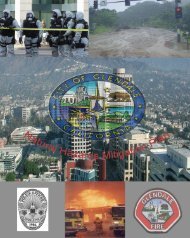Sayre Report - Hazard Mitigation Web Portal - State of California
Sayre Report - Hazard Mitigation Web Portal - State of California
Sayre Report - Hazard Mitigation Web Portal - State of California
Create successful ePaper yourself
Turn your PDF publications into a flip-book with our unique Google optimized e-Paper software.
the infiltration may be affected by the development <strong>of</strong> hydrophobic soils.<br />
Related is the increase in run<strong>of</strong>f resulting from reductions in interception <strong>of</strong><br />
the rain fall by the vegetation cover and infiltration due to the hydrophobic soil<br />
conditions. Hydrophobic soils develop where the waxy substances released<br />
by plant materials during hot fires follow thermal gradients into the soil and<br />
congeal as continuous surfaces/layers. (Further explanation is in the Soil<br />
<strong>Report</strong>.)<br />
Values at Risk near or within stream channels and those located adjacent to<br />
the basin spillways that outlet to the streets may be affected by significant inchannel<br />
floods, hyper-concentrated floods, debris torrents, and debris flows.<br />
It is our understanding that the USDA Forest Service, in concert with the US<br />
Geological Survey and CAL FIRE are developing models to assess the<br />
potential magnitudes <strong>of</strong> post-fire events.<br />
Houses and other features may be affected by local floods and slope failures<br />
as identified below. The magnitude <strong>of</strong> post-fire damage will be determined by<br />
the intensity and duration <strong>of</strong> rain storms that impact the area.<br />
B. Describe Condition <strong>of</strong> Values at Risk<br />
In addition to the sites previously identified by USDA Angeles National Forest<br />
Burned Area Emergency Response (BAER) Team. and the CAL OES <strong>Sayre</strong><br />
Fire BART survey team observed residences and other sites within and down<br />
slope from the burn area. The purpose <strong>of</strong> this survey was to evaluate<br />
potential risks from near-site debris flow, rock fall, floods, and other geologic<br />
hazards that may not have been identified in the regional evaluation. Of the<br />
thirty four (34) Values at Risk summary identified (see Appendix 1) by the<br />
survey team, only 2 sites (Pacoima Dam Office Building and Reservoir) were<br />
found at risk from the direct geologic impacts <strong>of</strong> rock fall and slides, and 26<br />
sites (chiefly the dam reservoir and debris basins) from debris flow or mud<br />
torrent flood inundation. The remaining sites were evaluated not to have a<br />
geologic impact.<br />
The Pacoima Dam Office is situated near the toe <strong>of</strong> a steep rock slope and is<br />
already subject to a significant rock fall hazard. A masonry wall, two timber<br />
lagging wall, and chain link fence have been placed at or near the toe <strong>of</strong> the<br />
slope to partially mitigate the hazard. The rock fall hazard potential has been<br />
increased due to the <strong>Sayre</strong> fire from denuding <strong>of</strong> the slope and thermal<br />
effects <strong>of</strong> the fire on the exposed rock face. Recent rock fall debris and dry<br />
ravel, along with the burnt timber lagging, and an impact scar to the masonry<br />
wall were observed during our reconnaissance <strong>of</strong> the site.<br />
The Pacoima Dam Reservoir is also already subject to a significant rock fall<br />
and landslide hazards from the adjacent slope areas. These potential risk<br />
have become increased due to both the <strong>Sayre</strong> Fire on the western side and

















